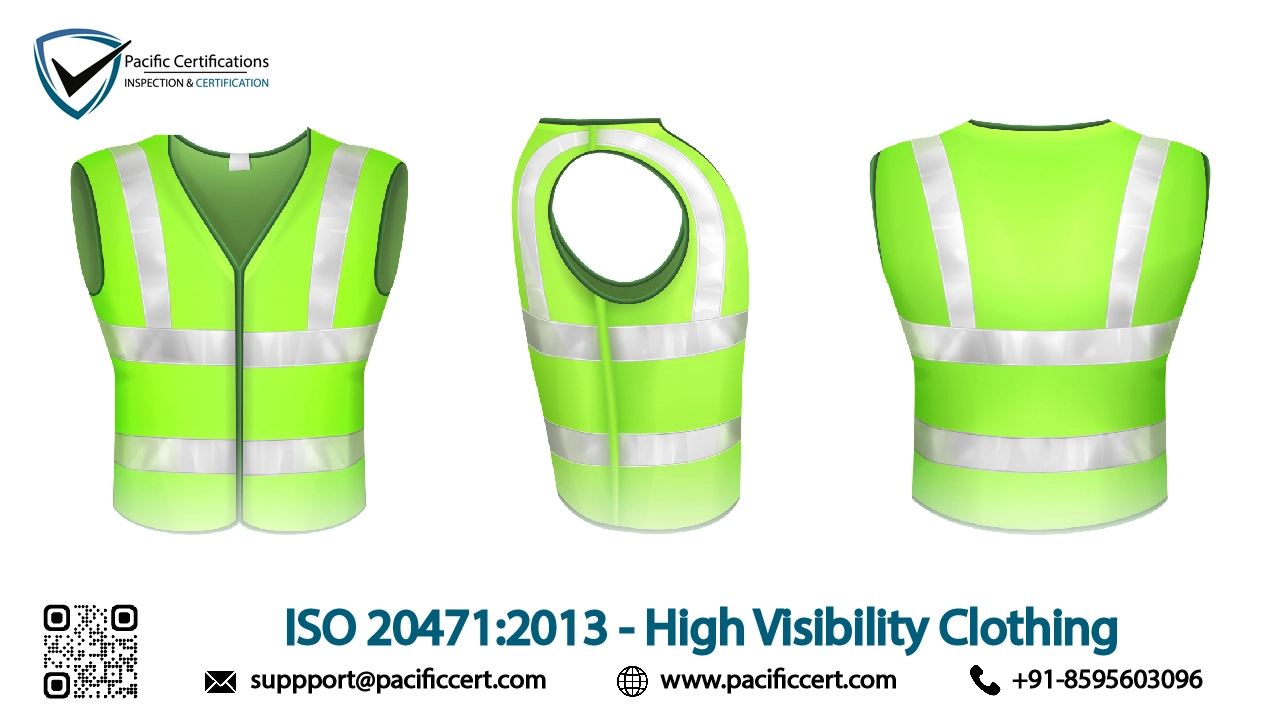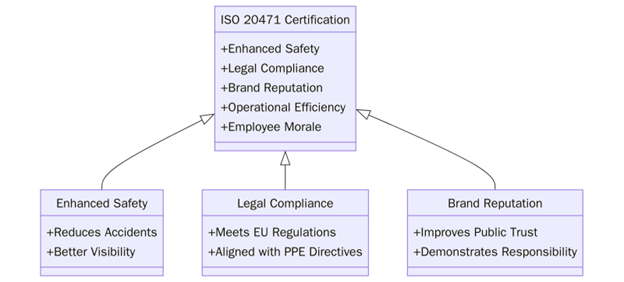What is EN ISO 20471:2013 Standard?

ISO 20471 specifies requirements for high visibility clothing designed to visually signal the user’s presence in hazardous environments during both daytime and nighttime conditions. The standard applies to garments that use fluorescent materials for daytime visibility and retroreflective materials for night-time detection. These garments are intended for use in occupational settings where workers are exposed to hazards from moving vehicles, machinery, or low visibility.
The standard ensures that high visibility clothing provides adequate visibility against various backgrounds and lighting conditions. It outlines performance classes, color specifications, retroreflective material quality, and placement of materials on garments such as jackets, vests, coveralls, and trousers. ISO 20471 helps manufacturers and employers design or select clothing that allows workers to be seen in poor lighting and complex work environments.

To begin the certification process for ISO 20471 for your safety gear manufacturing or procurement program, reach out to our team at support@pacificcert.com
What is the purpose of EN ISO 20471:2013?
The purpose of ISO 20471 is to minimize risks for people working in low visibility environments. The standard creates a uniform way to measure and classify visibility levels so that clothing manufacturers and employers can select garments that match job site conditions. It helps workers remain visible to equipment operators and drivers during all lighting conditions, which reduces incidents in transportation, roadwork, construction, and emergency response sectors.
Scope and Applicability
ISO 20471 is applicable to any industry where workers are exposed to moving vehicles, heavy equipment, or poor lighting. This includes road construction, warehouse operations, railways, ports, airports, mining, and waste collection. The standard is intended for high visibility garments that provide 360-degree visibility using a combination of fluorescent background materials and retroreflective tape. It does not apply to garments intended for non-occupational or recreational use.
Key Definitions
High visibility clothing: Garments designed to make the wearer more visible in hazardous or low-light environments using fluorescent and retroreflective materials
Background material: Fluorescent textile that makes the wearer more visible during daylight
Retroreflective material: Surface that reflects light back to its source to make the wearer visible at night
Combined performance material: Textile that includes both fluorescent and retroreflective properties
Performance class: Classification system (Class 1 to 3) based on minimum surface area and visibility performance
Clause-wise Structure of EN ISO 20471:2013
Clause | Title | Summary |
1 | Scope | Describes application and limitations of the standard |
2 | Normative references | Lists reference standards for material testing and visual properties |
3 | Terms and definitions | Provides definitions for key visibility terms and components |
4 | Design requirements | Outlines garment layout, placement of materials, and coverage zones |
5 | Material requirements | Specifies testing and performance of fluorescent and retroreflective surfaces |
6 | Test methods | Describes how visibility, durability, and brightness are verified |
7 | Marking and information | Specifies label content, sizing, and user instructions for garments |
8 | Performance classification | Details three classes based on minimum visible surface area |
What are the requirements of EN ISO 20471:2013?
Before applying for certification, organizations must ensure that their garments and design processes meet the core requirements. The standard outlines minimum performance thresholds for visibility and durability. Here are the key requirements:

- Select background and retroreflective materials that meet luminance and reflection thresholds
- Ensure garments provide 360-degree visibility with proper material placement
- Assign each garment to Class 1, 2, or 3 based on surface area
- Conduct testing for colorfastness, retroreflection, and resistance to weather and washing
- Maintain technical documentation for each product model
- Include product labeling and usage information for the end user
- Keep batch and production records for traceability
- Evaluate sample garments regularly to confirm ongoing conformity
- Verify garment fit and coverage does not compromise visibility
- Implement inspection and control plans for production batches
What are the benefits of EN ISO 20471:2013 Certification?
ISO 20471 certification gives organizations confidence in the performance of their visibility garments. This improves workplace safety and simplifies buyer decisions for safety-critical clothing. The benefits include:

- Lower risk of worker injury by improving daytime and nighttime visibility
- Standardized garment design and performance based on clear visibility classes
- Increased buyer trust through traceable quality assurance processes
- Clear labeling helps employers select garments suited for different job roles
- Better acceptance in government and large-scale infrastructure tenders
- Simplified training with consistent garment specifications
- Confidence that materials meet durability and light reflection benchmarks
- Improved compliance with worksite PPE requirements across multiple sectors
Now, more infrastructure and transport companies are requiring ISO 20471-compliant gear for worker uniforms. Municipal authorities and highway contractors have updated safety codes to prefer or mandate high visibility clothing with certified materials and testing records. There is also growing demand for dual-compliant garments that meet both ISO 20471 and flame-retardant standards for oil, gas, and utility sectors.
Certification Process: EN ISO 20471:2013
- Gap Assessment (optional)
- Stage 1 Audit – Documentation review and sample evaluation
- Stage 2 Audit – On-site inspection of production and testing records
- Surveillance Audits – Annual reviews of materials and batch control
- Recertification – Once every three years
Timeline for EN ISO 20471:2013 Certification
The full process typically takes between 6 to 10 weeks depending on readiness and product complexity. Companies with pre-tested materials and garment samples can complete the audit faster. Delays may occur if corrective action is needed or if multiple garment classes are being certified at once.
What is the cost of ISO 20471:2013?
Certification costs vary based on the number of garment models, product lines, and production locations involved. Pricing also depends on whether testing is already completed or needs to be independently verified. Additional expenses may include test reports, labeling updates, and on-site evaluations. Companies looking to combine ISO 20471 with other certifications like ISO 13688 or flame-retardant standards may see bundled audit efficiencies.
How can Pacific Certifications help?
Pacific Certifications certifies high visibility clothing in line with ISO 20471. We support PPE manufacturers, garment exporters, and procurement divisions by:
- Conducting certification audits and verifying garment design
- Reviewing product samples, technical files, and labeling
- Evaluating test reports for retroreflective and fluorescent material performance
- Ensuring classification of garments aligns with ISO 20471 surface area rules
- Supporting brands, government suppliers, and uniform vendors with third-party certification
- Providing audit decisions based solely on sample evidence and process records
Training and Courses
Lead Auditor Training – For third-party auditors who wish to assess PPE garment producers
Lead Implementer Training – For QA leads managing ISO 20471 compliance in-house
Internal Auditor Training – For in-factory quality teams verifying garment visibility during production
Pacific Certifications provides accredited training programs. If your organization is looking for ISO 20471 training, our team is equipped to help you. Contact us at support@pacificcert.com
FAQs
What is ISO 20471:2013?
It’s the international standard for high-visibility clothing that makes the wearer conspicuous in daylight and under vehicle headlights, aimed at people working around traffic or moving equipment
What are the three classes in ISO 20471?
Hi-vis garments are rated Class 1, 2, or 3 based on how much fluorescent and retroreflective material they use—the higher the class, the greater the visibility.
What does “Class 3” mean and when is it used?
Class 3 gives the highest visibility and is recommended for dark conditions or traffic speeds over ~60 km/h; it must cover the torso and usually includes sleeves and/or trouser legs with reflective bands
Which colors are allowed for ISO 20471 hi-vis?
The standard uses bright fluorescent background colors—typically yellow, orange, or red—to create strong contrast in daylight.
How did ISO 20471 replace EN 471?
EN ISO 20471 (2013) superseded EN 471 to unify testing and tighten design rules (for example, fully fluorescent sleeves versus older allowances).
What does the label need to show (marking & washing)?
Labels show the hi-vis pictogram and the garment’s class, plus the maximum number of washing cycles declared by the manufacturer; testing of retroreflective tape is linked to that care process
How are the classes determined?
Garments are classified as Class 1, 2, or 3 based on the surface area of visible materials.
Is testing part of the certification?
Yes. Materials must be tested for color, retroreflection, and resistance to wear and washing.
Does ISO 20471 apply to casual wear?
No. It is intended for occupational use in environments with visibility risks.
Can small PPE manufacturers apply for ISO 20471?
Yes. The standard applies to all garment producers regardless of size.
Ready to get ISO 20471 certified?
Contact Pacific Certifications to begin your certification journey today!
Suggested Certifications –
Read more: Pacific Blogs






